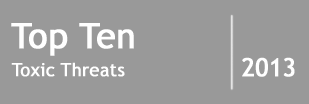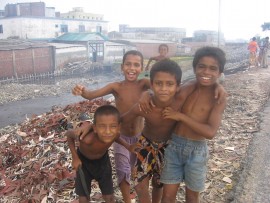Hazaribagh, Bangladesh
Pollutant: Mainly Chromium
Population Affected: 160,000+
There are 270 registered tanneries in Bangladesh, and around 90-95 percent are located at Hazaribagh on about 25 hectares of land. Most of these use old, outdated, and inefficient processing methods. Together, the tanneries employ anywhere between 8,000 and 12,000 people.[1] Every day, the tanneries collectively dump 22,000 cubic liters of toxic waste, including cancer-causing hexavalent chromium, into the Buriganga, Dhaka's main river and a key water supply.[2] The homes of tannery workers in Hazaribagh are built next to contaminated streams, ponds, and canals. Informal leather recyclers who burn scraps of leather to produce a number of consumer products also heavily pollute the air.[3]
Aside from the fact that hexavalent chromium is a well-known carcinogen, workers and local residents also face a number of less severe yet more common health problems every day. Skin and respiratory diseases, for instance, result from repeated exposure to hazardous chemicals when measuring and mixing them as part of the tanning process. Acid burns, rashes, aches, dizziness, and nausea are also common health problems faced by local residents.[4] The 2011 census lists the total population of the Hazaribagh sub-district as just over 185,000, though reliable data in relation to residents residing in the informal settlements is difficult to come by.[5]
[1] Environmental Concerns regarding Hazaribagh Tannery area and Present Relocation Scenario (2011).
[2] Human Rights Watch, 2012. Toxic Tanneries: The Health Repercussions of Bangladesh’s Hazaribagh Leather. Available at: http://www.hrw.org/sites/default/files/reports/bangladesh1012webwcover.pdf
[3] "Material Damage. Toxic Tanneries Cause Lasting Harm." Hazards Magazine 2012: Issue 120. Web. <http://www.hazards.org/workingworld/materialdamage.htm>.
[4] Human Rights Watch, 2012. Toxic Tanneries: The Health Repercussions of Bangladesh’s Hazaribagh Leather. Available at: http://www.hrw.org/sites/default/files/reports/bangladesh1012webwcover.pdf
[5] Bangladesh Bureau of Statistics, “Household, Population, Sex Ratio and Literacy Rate,” 2011, table C-01 http://www.bbs.gov.bd/PageWebMenuContent.aspx?MenuKey=439.




